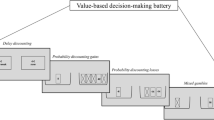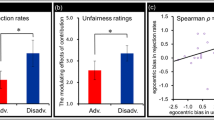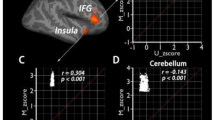Abstract
Regret affects decision-making behavior, which is mediated by a cognitive process known as counterfactual thinking in economic science. Several studies indicate that orbitofrontal cortex (OFC) plays a crucial role in decision-making behavior. However, the neural correlates of regret trait and the function of the OFC in decision-making remain unclear. In this study, we employed a typical monetary decision-making task, a modified ‘Wheel of Fortune gamble’ paradigm, to investigate decision-making behavior and its neural mechanism. We combined voxel-based morphometry (VBM) and task-evoked functional magnetic resonance imaging (fMRI) analyses to explore the neural substrates of regret trait. VBM analyses revealed that individual Regret Scale Score was negatively associated with the gray-matter volume (GMV) in the frontal and temporal areas, including the bilateral OFC. These results indicate that individuals with high regret trait have smaller GMV in these areas. Moreover, we found stronger task-evoked activation of the left OFC in high regret trait individuals during the decision-maker’s choice (choose conditions) phase, whereas we did not find this relationship in computer-selected’s (follow conditions) choice phase. Using generalized psychophysiological interactions (PPI) analysis, we further found that the functional connectivity of the left OFC to right inferior frontal gyrus and left cerebellum was stronger in the complete feedback choose condition (under regret theoretical framework) than partial feedback choose condition (under disappointment theoretical framework). These findings verify the critical role of the OFC in the decision-making, more importantly, provide novel insights into the morphological and functional substrates of individual regret trait.




Similar content being viewed by others
Availability of data and materials
The datasets used and/or analyzed during the current study are available from the corresponding author on reasonable request.
Code availability
The code used and/or analyzed during the current study is available from the corresponding author on reasonable request.
References
Abe H, Lee D (2011) Distributed coding of actual and hypothetical outcomes in the orbital and dorsolateral prefrontal cortex. Neuron. https://doi.org/10.1016/j.neuron.2011.03.026
Arielle BS, Stuppy-Sullivan AM, Buckholtz JW (2016) Psychopathic individuals exhibit but do not avoid regret during counterfactual decision making. Proc Natl Acad Sci U S A. https://doi.org/10.1073/pnas.1609985113
Aydogan G, Daviet R, Karlsson Linnér R et al (2021) Genetic underpinnings of risky behaviour relate to altered neuroanatomy. Nat Hum Behav. https://doi.org/10.1038/s41562-020-01027-y
Balleine BW (2021) Emotional predictions and choice. Nat Hum Behav. https://doi.org/10.1038/s41562-021-01208-3
Banks SJ, Eddy KT, Angstadt M et al (2007) Amygdala-frontal connectivity during emotion regulation. Soc Cogn Affect Neurosci. https://doi.org/10.1093/scan/nsm029
Basti A, Mur M, Kriegeskorte N et al (2019) Analysing linear multivariate pattern transformations in neuroimaging data. PLoS ONE. https://doi.org/10.1371/journal.pone.0223660
Bault N, Wydoodt P, Coricelli G (2016) Different attentional patterns for regret and disappointment: an eye-tracking study. J Behav Decis Mak. https://doi.org/10.1002/bdm.1938
Bell DE (1982) Regret in decision making under uncertainty. Oper Res V. https://doi.org/10.1287/opre.30.5.961
Bell DE (1985) Disappointment in decision making under uncertainty. Oper Res. https://doi.org/10.1287/opre.33.1.1
Blackwood N, Ffytche D, Simmons A et al (2004) The cerebellum and decision making under uncertainty. Cogn Brain Res. https://doi.org/10.1016/j.cogbrainres.2003.12.009
Bokde ALW, Tagamets MA, Friedman RB, Horwitz B (2001) Functional interactions of the inferior frontal cortex during the processing of words and word-like stimuli. Neuron. https://doi.org/10.1016/S0896-6273(01)00288-4
Camille N, Coricelli G, Sallet J et al (2004) The involvement of the orbitofrontal cortex in the experience of regret. Science. https://doi.org/10.1126/science.1094550
Camille N, Pironti VA, Dodds CM et al (2010) Striatal sensitivity to personal responsibility in a regret-based decision-making task. Cogn Affect Behav Neurosci. https://doi.org/10.3758/CABN.10.4.460
Chua HF, Gonzalez R, Taylor SF et al (2009) Decision-related loss: regret and disappointment. Neuroimage. https://doi.org/10.1016/j.neuroimage.2009.06.006
Clausi S, Coricelli G, Pisotta I et al (2015) Cerebellar damage impairs the self-rating of regret feeling in a gambling task. Front Behav Neurosci. https://doi.org/10.3389/fnbeh.2015.00113
Coricelli G, Critchley HD, Joffily M et al (2005) Regret and its avoidance: a neuroimaging study of choice behavior. Nat Neurosci. https://doi.org/10.1038/nn1514
Coricelli G, Dolan RJ, Sirigu A (2007) Brain, emotion and decision making: the paradigmatic example of regret. Trends Cogn Sci. https://doi.org/10.1016/j.tics.2007.04.003
D’Angelo E, Casali S (2012) Seeking a unified framework for cerebellar function and dysfunction: from circuit operations to cognition. Front Neural Circ. https://doi.org/10.3389/fncir.2012.00116
Dai Q, Xuntao Y, Zhengzhi F (2017) Rewarding network mechanism of left orbito-frontal cortex transcranial magnetic stimulation in depression. Eur Psychiatry. https://doi.org/10.1016/j.eurpsy.2017.01.1980
Epstude K, Roese NJ (2008) The functional theory of counterfactual thinking. Personal Soc Psychol Rev. https://doi.org/10.1177/1088868308316091
Fatemi SH, Aldinger KA, Ashwood P et al (2012) Consensus paper: pathological role of the cerebellum in Autism. Cerebellum. https://doi.org/10.1007/s12311-012-0355-9
Feldstein Ewing SW, Chung T, Caouette JD et al (2017) Orbitofrontal cortex connectivity as a mechanism of adolescent behavior change. Neuroimage. https://doi.org/10.1016/j.neuroimage.2016.12.076
Gardner MPH, Conroy JC, Styer CV et al (2018) Medial orbitofrontal inactivation does not affect economic choice. Elife. https://doi.org/10.7554/eLife.38963
Gillan CM, Morein-Zamir S, Kaser M et al (2014) Counterfactual processing of economic action-outcome alternatives in obsessive-compulsive disorder: further evidence of impaired goal-directed behavior. Biol Psychiatry. https://doi.org/10.1016/j.biopsych.2013.01.018
Giorgetta C, Grecucci A, Bonini N et al (2013) Waves of regret: a meg study of emotion and decision-making. Neuropsychologia. https://doi.org/10.1016/j.neuropsychologia.2012.10.015
Guggisberg AG, Dalal SS, Findlay AM, Nagarajan SS (2008) High-frequency oscillations in distributed neural networks reveal the dynamics of human decision making. Front Hum Neurosci. https://doi.org/10.3389/neuro.09.014.2007
Habas C, Kamdar N, Nguyen D et al (2009) Distinct cerebellar contributions to intrinsic connectivity networks. J Neurosci. https://doi.org/10.1523/JNEUROSCI.1868-09.2009
Hastie T, Tibshirani R, Friedman J (2009) The elements of statistical learning, vol 27, 2nd edn. Springer, New York, pp 337–387
Heffner J, Son J-Y, FeldmanHall O (2021) Emotion prediction errors guide socially adaptive behaviour. Nat Hum Behav. https://doi.org/10.1038/s41562-021-01213-6
Hilger K, Winter NR, Leenings R et al (2020) Predicting intelligence from brain gray matter volume. Brain Struct Funct. https://doi.org/10.1007/s00429-020-02113-7
Howard JD, Kahnt T (2018) Identity prediction errors in the human midbrain update reward-identity expectations in the orbitofrontal cortex. Nat Commun. https://doi.org/10.1038/s41467-018-04055-5
Hua Y, Li M, Wang Q et al (2020) The role of left orbitofrontal cortex in selective attention during automatic emotion regulation: evidence from transcranial direct current stimulation. Acta Psychol Sin. https://doi.org/10.3724/SP.J.1041.2020.01048
Lak A, Costa GM, Romberg E et al (2014) Orbitofrontal cortex is required for optimal waiting based on decision confidence. Neuron. https://doi.org/10.1016/j.neuron.2014.08.039
Larquet M, Coricelli G, Opolczynski G, Thibaut F (2010) Impaired decision making in schizophrenia and orbitofrontal cortex lesion patients. Schizophr Res. https://doi.org/10.1016/j.schres.2009.11.010
Levens SM, Larsen JT, Bruss J et al (2014) What might have been? The role of the ventromedial prefrontal cortex and lateral orbitofrontal cortex in counterfactual emotions and choice. Neuropsychologia. https://doi.org/10.1016/j.neuropsychologia.2013.10.026
Li H, Li W, Wei D et al (2014) Examining brain structures associated with perceived stress in a large sample of young adults via voxel-based morphometry. Neuroimage. https://doi.org/10.1016/j.neuroimage.2014.01.044
Lin Q, Manley J, Helmreich M et al (2020) Cerebellar neurodynamics predict decision timing and outcome on the single-trial level. Cell. https://doi.org/10.1016/j.cell.2019.12.018
Litt A, Plassmann H, Shiv B, Rangel A (2011) Dissociating valuation and saliency signals during decision-making. Cereb Cortex. https://doi.org/10.1093/cercor/bhq065
Liu X, Powell DK, Wang H et al (2007) Functional dissociation in frontal and striatal areas for processing of positive and negative reward information. J Neurosci. https://doi.org/10.1523/JNEUROSCI.5227-06.2007
Liu Z, Li L, Zheng L et al (2016) The neural basis of regret and relief during a sequential risk-taking task. Neuroscience. https://doi.org/10.1016/j.neuroscience.2016.04.018
Loomes G, Sugden R (1982) Regret theory: an alternative theory of rational choice under uncertainty. Econ J. https://doi.org/10.2307/2232669
Loomes G, Sugden R (1986) Disappointment and dynamic consistency in choice under uncertainty. Rev Econ Stud. https://doi.org/10.2307/2297651
Ma M, Futia GL, de Souza FMS et al (2020) Molecular layer interneurons in the cerebellum encode for valence in associative learning. Nat Commun. https://doi.org/10.1038/s41467-020-18034-2
Masset P, Ott T, Lak A et al (2020) Behavior- and modality-general representation of confidence in orbitofrontal cortex. Cell. https://doi.org/10.1016/j.cell.2020.05.022
McLaren DG, Ries ML, Xu G, Johnson SC (2012) A generalized form of context-dependent psychophysiological interactions (gPPI): a comparison to standard approaches. Neuroimage. https://doi.org/10.1016/j.neuroimage.2012.03.068
Mellers B, Schwartz A, Ritov I (1999) Emotion-based choice. J Exp Psychol Gen. https://doi.org/10.1037/0096-3445.128.3.332
Nakamura M, Nestor PG, Levitt JJ et al (2008) Orbitofrontal volume deficit in schizophrenia and thought disorder. Brain. https://doi.org/10.1093/brain/awm265
Nejati V, Salehinejad MA, Nitsche MA (2018) Interaction of the left dorsolateral prefrontal cortex (l-DLPFC) and right orbitofrontal cortex (OFC) in hot and cold executive functions: evidence from transcranial direct current stimulation (tDCS). Neuroscience. https://doi.org/10.1016/j.neuroscience.2017.10.042
O’Reilly JX, Woolrich MW, Behrens TEJ et al (2012) Tools of the trade: psychophysiological interactions and functional connectivity. Soc Cogn Affect Neurosci. https://doi.org/10.1093/scan/nss055
Padoa-Schioppa C, Conen KE (2017) Orbitofrontal cortex: a neural circuit for economic decisions. Neuron. https://doi.org/10.1016/j.neuron.2017.09.031
Pisauro MA, Fouragnan E, Retzler C, Philiastides MG (2017) Neural correlates of evidence accumulation during value-based decisions revealed via simultaneous EEG-fMRI. Nat Commun. https://doi.org/10.1038/ncomms15808
Platt ML (2002) Neural correlates of decisions. Curr Opin Neurobiol. https://doi.org/10.1016/S0959-4388(02)00302-1
Rao VR, Sellers KK, Wallace DL et al (2018) Direct electrical stimulation of lateral orbitofrontal cortex acutely improves mood in individuals with symptoms of depression. Curr Biol. https://doi.org/10.1016/j.cub.2018.10.026
Ritov I, Baron J (1990) Reluctance to vaccinate: omission bias and ambiguity. J Behav Decis Mak. https://doi.org/10.1002/bdm.3960030404
Roese NJ, Park S, Smallman R, Gibson C (2008) Schizophrenia involves impairment in the activation of intentions by counterfactual thinking. Schizophr Res. https://doi.org/10.1016/j.schres.2007.05.006
Rosenbloom MH, Schmahmann JD, Price BH (2012) The functional neuroanatomy of decision-making. J Neuropsychiatry Clin Neurosci. https://doi.org/10.1176/appi.neuropsych.11060139
Schmahmann JD (2010) The role of the cerebellum in cognition and emotion: personal reflections since 1982 on the dysmetria of thought hypothesis, and its historical evolution from theory to therapy. Neuropsychol Rev. https://doi.org/10.1007/s11065-010-9142-x
Schrouff J, Rosa MJ, Rondina JM et al (2013) PRoNTo: Pattern recognition for neuroimaging toolbox. Neuroinformatics. https://doi.org/10.1007/s12021-013-9178-1
Schutter DJLG, van Honk J (2005) The cerebellum on the rise in human emotion. The Cerebellum 4:290–294. https://doi.org/10.1080/14734220500348584
Schwartz B, Ward A, Lyubomirsky S et al (2002) Maximizing versus satisficing: happiness is a matter of choice. J Pers Soc Psychol. https://doi.org/10.1037/0022-3514.83.5.1178
Sharma SN, Khan A (2021) Intertemporal preference reversals are associated with early activation of insula and sustained preferential processing of immediate rewards in visual cortex. Sci Rep. https://doi.org/10.1038/s41598-021-01579-7
Shimanoff SB (1984) Commonly named emotions in everyday conversations. Percept Mot Skills. https://doi.org/10.2466/pms.1984.58.2.514
Sommer T, Peters J, Gläscher J, Büchel C (2009) Structure-function relationships in the processing of regret in the orbitofrontal cortex. Brain Struct Funct. https://doi.org/10.1007/s00429-009-0222-8
Stalnaker TA, Cooch NK, Schoenbaum G (2015) What the orbitofrontal cortex does not do. Nat Neurosci. https://doi.org/10.1038/nn.3982
Steiner AP, Redish AD (2014) Behavioral and neurophysiological correlates of regret in rat decision-making on a neuroeconomic task. Nat Neurosci. https://doi.org/10.1038/nn.3740
Tarhan L, Konkle T (2020) Reliability-based voxel selection. Neuroimage. https://doi.org/10.1016/j.neuroimage.2019.116350
Uddin LQ (2021) Cognitive and behavioural flexibility: neural mechanisms and clinical considerations. Nat Rev Neurosci. https://doi.org/10.1038/s41583-021-00428-w
Uretzky S, Gilboa A (2010) Knowing your lines but missing your cue: rostral prefrontal lesions impair prospective memory cue detection, but not action-intention superiority. J Cogn Neurosci 22:2745–2757. https://doi.org/10.1162/jocn.2010.21419
Wagner MJ, Kim TH, Savall J et al (2017) Cerebellar granule cells encode the expectation of reward. Nature. https://doi.org/10.1038/nature21726
Wang Q, Wei S, Im H et al (2021) Neuroanatomical and functional substrates of the greed personality trait. Brain Struct Funct. https://doi.org/10.1007/s00429-021-02240-9
Xiang Y, Zhao S, Wang H et al (2017) Examining brain structures associated with dispositional envy and the mediation role of emotional intelligence. Sci Rep. https://doi.org/10.1038/srep39947
Xie K, Jin Z, Ni X et al (2020) Distinct neural substrates underlying target facilitation and distractor suppression: a combined voxel-based morphometry and resting-state functional connectivity study. Neuroimage. https://doi.org/10.1016/j.neuroimage.2020.117149
Xin F, Zhou X, Dong D et al (2020) Oxytocin differentially modulates amygdala responses during top-down and bottom-up aversive anticipation. Adv Sci. https://doi.org/10.1002/advs.202001077
Yan CG, Di WX, Zuo XN, Zang YF (2016) DPABI: data processing & analysis for (resting-state) brain imaging. Neuroinformatics 14:339–351. https://doi.org/10.1007/s12021-016-9299-4
Yu P, Lu X, Chen Y et al (2021) Modulating OFC activity with tDCS alters regret about human decision-making. Front Psychol. https://doi.org/10.3389/fpsyg.2021.706962
Zald DH, McHugo M, Ray KL et al (2014) Meta-analytic connectivity modeling reveals differential functional connectivity of the medial and lateral orbitofrontal cortex. Cereb Cortex. https://doi.org/10.1093/cercor/bhs308
Zalla T, Sirigu A, Robic S et al (2014) Feelings of regret and disappointment in adults with high-functioning autism. Cortex. https://doi.org/10.1016/j.cortex.2014.05.008
Zeelenberg M, Pieters R (1999) Comparing service delivery to what might have Been: behavioral responses to regret and disappointment. J Serv Res. https://doi.org/10.1177/109467059921007
Zhang Q, Wang H, Luo C et al (2019) The neural basis of semantic cognition in Mandarin Chinese: a combined fMRI and TMS study. Hum Brain Mapp. https://doi.org/10.1002/hbm.24781
Funding
This research was supported by Grants from National Nature Science Foundation of China (62176045), by the Programme of Introducing Talents of Discipline to Universities (the 111 project B12027), Sichuan Province Science and Technology Innovation Cultivation Project (2022014), and the Fundamental Research Funds for the Central Universities (ZYGX2020FRJH014).
Author information
Authors and Affiliations
Contributions
We are grateful to all the participants in this study. Writing—original draft, investigation, methodology, data collection, and analysis: TZ. Data collection and resources: QZ, JW, MW, and WL. Writing—review and editing: JY, JZ, and ZJ. Supervision, funding acquisition, project administration, and writing—review & editing: LL. All authors reviewed the manuscript.
Corresponding authors
Ethics declarations
Conflict of interest
The authors declare that they have no competing interests.
Ethics approval
We received each subject’s written permission prior to this study. The experimental procedures were carried out in accordance with the Declaration of Helsinki and were approved by the Institutional Review Board of the University of Electronic Science and Technology of China.
Consent to participate
Informed consent was obtained from all individual subjects included in the study.
Additional information
Publisher's Note
Springer Nature remains neutral with regard to jurisdictional claims in published maps and institutional affiliations.
Supplementary Information
Below is the link to the electronic supplementary material.
Rights and permissions
Springer Nature or its licensor holds exclusive rights to this article under a publishing agreement with the author(s) or other rightsholder(s); author self-archiving of the accepted manuscript version of this article is solely governed by the terms of such publishing agreement and applicable law.
About this article
Cite this article
Zhang, T., Zhang, Q., Wu, J. et al. The critical role of the orbitofrontal cortex for regret in an economic decision-making task. Brain Struct Funct 227, 2751–2767 (2022). https://doi.org/10.1007/s00429-022-02568-w
Received:
Accepted:
Published:
Issue Date:
DOI: https://doi.org/10.1007/s00429-022-02568-w




